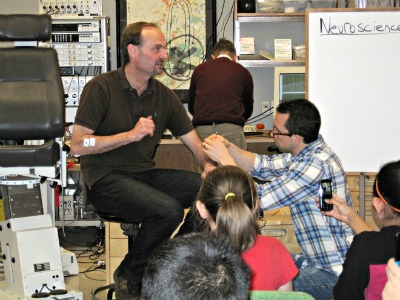
Neuroscientist Dave Collins and PhD student, Austin Bergquist, set up for their first experiment
"What's that string in your arm?" The grade six visit has barely begun, but the questions are already flying. One earnest keener in the front row of Dave Collins's neuroscience lab is pointing to the thin wire electrode protruding from his arm.
"That's not a string, it's a wire," explains Collins, and to the spellbound audience of 20-plus grade six students from Tepaskin School in Millwoods, now rapt and craning to see, this is science like they've never experienced it before. Collins, with other electrodes stuck to the skin of his arm tells his audience, "First I'm going to show you a recording from my heart muscle, then from these electrodes here (on my arm) and then the wire."
The recordings from the muscles were displayed on a computer screen and were also played through stereo speakers, allowing the students to see and hear the electrical activity muscles make when they contract.
Collins's research focuses on understanding how the nervous system controls human movement, the role of the brain and spinal cord, and the reflex pathways that travel through the spinal cord, with the goal of developing ways to give people with spinal cord injuries some control of their movements. And his lab is a popular one for school visits.
"Does it hurt?" Another one asks. There's wide-eyed, slack-jawed squirming in seats when Collins tells them how he poked the needle and wire into his muscle, then pulled the needle out, leaving the wire in the muscle.
"When muscles contract they give off tiny little electrical signals," Collins tells the class. "When I flex my arm and my bicep muscle is contracting it's giving off little electrical signals. We can record that. We can record muscles from the surface of the skin or we can put wires right into the muscle and record from them."
When Collins invites the students to be part of a 'muscle band' there's no hesitation. With electrodes stuck to the skin of his young volunteers' arms, wrists, fingers and cheeks, Collins conducts his 'muscle orchestra' like a maestro, pointing to the kids to contract the muscle under the electrode when he points to them. Soon there's a cacophony of deep thundering crackles and pops, squaring off with barely audible squeaks as the 'musicians' tease muscles from gentle whispers to raucous crescendo.
But the piece de resistance is certainly when Collins demonstrates the transcranial magnetic stimulator which shows the cross-sections of his brain and by moving the stimulator over the brain, students can clearly see how the right side of the brain controls the left side of the body and vice versa as Collins's arms and legs twitch involuntarily with each pulse from the stimulator.
To teacher, Melanie Parks, this is what learning is all about. "The university provides an invaluable service to young learners in expanding their horizons of what's possible but probably the most valuable thing is that it opens their eyes to all of the other opportunities out there. Kids often live in their own little worlds and it really opens up an understanding of more things they can study, ways they can study and places they can study them and that learning is limitless."
To Collins, it's part of being a professor and what university is really all about. "It's inspirational really. When I see their wide-eyed excitement and answer their surprisingly insightful questions it reminds me of the curiosity that got me interested in this whole area in the first place. I just hope the students have as much fun visiting the lab as we have hosting them!"